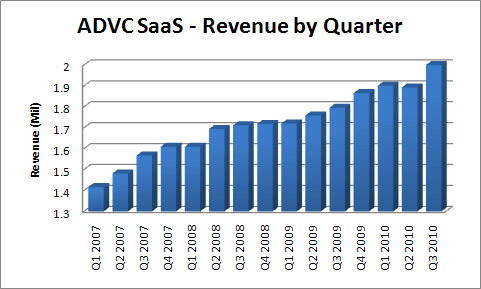Access Plans (APNC.OB) has been featured on Value Uncovered several times before (see here and here).
The company continues to put up record results and is on pace for its best year ever, yet the stock has languished below $1 for most of 2010.
Strategic Alternatives
Based on recent news, it appears that management agrees with my analysis.
On November 11, APNC announced that it will pursue a broad range of strategic alternatives to enhance shareholder value.
These alternatives include a possible going private transaction or raising money for future acquisitions.
For many micro-cap stocks, especially those quoted outside of the major exchanges, it is often difficult to rise above the crowd.
The market hasn’t responded to APNC’s latest acquisition, nor its growth prospects going forward, so it appears to be in the company’s best interests to strongly consider taking the company private.
The stock market has at least responded favorably to this news, as the stock is up over 12% in the past few days.
Research Report
On the heels of this strategic announcement, a research report was also published by RJ Falkner & Company, describing APNC as a “diamond in the rough” type of investment opportunity.
While the report is certainly biased (RJ Falkner is compensated for their services), I think it echoes a number of valid points that I have brought up before.
I have grouped together a few excerpts:
Efficient Operations
“Access Plans should require minimal capital to execute its business strategy, since it does not have to inventory products and services. This suggests that the Company should generate a significant and growing stream of “free” cash flow from operations that could be available for acquisitions, future cash dividends, and/or stock repurchases.”
Management is in the process of transitioning its new Insurance Marketing division (a very low margin business) to its more lucrative membership plan options, which should provide a significant boost to how much cash hits the bottom line.
“APNC now has an opportunity to increase sales of high-margin healthcare benefit programs through its national network of health insurance agents and through other non-affiliated health insurance agencies.”
And management has done it before with the Retail Plans division:
“This division has replicated many of the features that have allowed the Wholesale Plans Division to be highly successful in the rent-to-own industry in the development of plans for other retailers and direct marketing channels”
Macro Trends
The number of businesses offering health insurance coverage is shrinking:
“As the number of uninsured individuals has increased, the market potential for APNC’s non-insurance healthcare savings programs has expanded significantly.”
In addition, baby boomers are starting to retire, increasing the demand for healthcare services – and Medicare doesn’t cover everything:
“While the federal Medicare program covers a portion of healthcare expenses for senior Americans, gaps in coverage provide a significant market for APNC’s supplemental healthcare savings programs.”
Financials & Valuation
“For the year ended September 30, 2010, we expect the Company to report net income of over $3.0 million, or $0.15 per diluted share, on revenues of approximately $54 million, representing an after-tax return on beginning shareholders’ equity of approximately 26.2%.”
The company has paid down nearly all of its long-term debt, is buying back shares, and will likely have a record year in cash flow and profits.
“Based upon a generally accepted “rule of thumb” that growth stocks should command a P/E ratio of approximately 1X their earnings growth rate, we believe APNC shares should sell for at least 13X-15X earnings as the success of the Company’s business model becomes apparent to investors. Based upon our EPS estimate ($0.21-$0.22) for the upcoming fiscal year, this suggests the potential for capital appreciation of 215%-290% in APNC shares (to the $2.70-$3.30 area) over the next 12-18 months.”
While this forecast is very optimistic, my own estimates peg an intrinsic value of $1.70 under the most conservative estimates (no growth, current FCF levels), and a more likely valuation scenario of $2-$2.50.
Conclusion
As I’ve said in my previous write-up, investors seem to be concerned that the financial reform bill will negatively impact APNC ‘s operations – in truth, the net result is probably the opposite.
I’m encouraged to see that management is willing to explore options to reward existing shareholders.
It remains to be seen how the story plays out, but it appears that APNC’s future could yield substantial upside.
Disclosure
Long APNC. No affiliation with RJ Falkner & Company.

